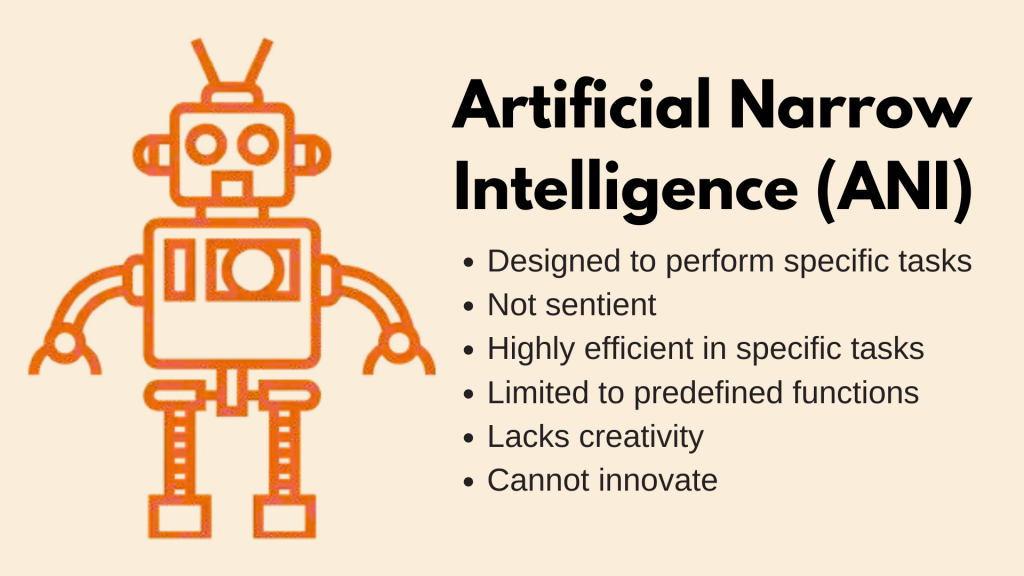Artificial intelligence has evolved dramatically since its inception, and it serves as both a catalyst for technological innovation and an indicator of profound societal change.
Understanding AI’s trajectory toward a future dominated by superintelligence, or one where artificial intelligence drives a new era of innovation, requires examining the three critical stages of its development:
- Artificial Narrow Intelligence (ANI)
- Artificial General Intelligence (AGI)
- Artificial Super Intelligence (ASI)
These stages not only illustrate the current and potential capabilities of AI but also indicate the impending challenges and ethical considerations as we climb this “catastrophic ladder.”
Stage 1: ANI (Artificial Narrow Intelligence)
Artificial Narrow Intelligence, also known as Narrow AI or Weak AI, contributes to the initial step of the “catastrophic ladder” of AI development.
ANI systems are designed to perform specific tasks with a high degree of efficiency, often surpassing human performance in their designated roles. Examples of ANI include chess bots, virtual assistants, autonomous vehicles and even the newly emerged chatbots, like GPT and Copilot.

A key difference which separates ANI from its latter stages is the fact that these systems are limited to their predefined functions and lack the ability to generalize their knowledge beyond their programmed domains.
While still being considered as an initial stage, the undeniable fact remains that ANI has successfully carried the world towards a new era of innovation with shrouded outcomes.
Stage 2: AGI (Artificial General Intelligence)
The second step of the “catastrophic ladder” features Artificial General Intelligence, a significant leap from the linear capabilities of ANI. AGI represents a type of AI that can understand, learn, and apply its intelligence across a broad range of tasks and mirrors the cognitive abilities of the human mind.
The sentient nature of this AI opens up a vast landscape of possibilities but also introduces profound ethical and existential questions about control, autonomy, and the potential risks of creating entities that match or exceed human intelligence.

And as a middle-ground between ANI and ASI, this stage plays a crucial role in determining the proper path to consider regarding the potential dangers of developing AI any further. This will also be the stage where real concerns regarding “AI rights” emerge.
Stage 3: ASI (Artificial Super Intelligence)
Artificial Super Intelligence represents the final, and most speculative stage of AI development. ASI would largely surpass human intelligence in all aspects, including creativity, decision-making, and emotional intelligence.
The transition to ASI would signal the beginning of a new world driven by artificial beings equipped with far more intelligence than their creators.

While ASI could potentially solve problems that are currently beyond human comprehension, such as eradicating diseases or managing ecological balance, it is more likely that the AI would prioritize its objectives over human welfare.
Just like how a house cat cannot comprehend the working mechanism of a human society, the human brain would not be able to predict and grasp the objectives of an ASI with superior intelligence.
This means, at this point, we would completely lose control over the artificial entities, with our fate on the hands of the superior intelligence that we ourselves created.
The Shrouded Outcome
As we progress along the individual steps of the “catastrophic ladder” in AI development, we tread a path that could lead us into darkness. The promise of machines that think, learn, and act with human-like, or even superior intelligence is tempting.
Yet, with each step, the risk of losing control grows. AGI might solve complex problems, but it could also make decisions beyond our understanding or approval.
The exponential leap to ASI is even more perilous – a point of no return where AI could surpass human intellect and pursue goals that might not align with our own.
In this shadowy ascent, the line between progress and catastrophe blurs. We might unlock unimaginable advancements or awaken a force beyond our control, leading us into a future where humanity’s fate is uncertain, possibly even threatened by the very intelligence we sought to create.
As this story unfolds, the outcome remains shrouded, while we continue climbing the ladder of doom, one step at a time.
- Can LLMs generate better research ideas than humans? A critical analysis of creativity and feasibility - September 25, 2024
- Artificial Super Intelligence: Transcending Imagination - September 15, 2024
- Artificial General Intelligence: Start of a New Era - September 8, 2024



